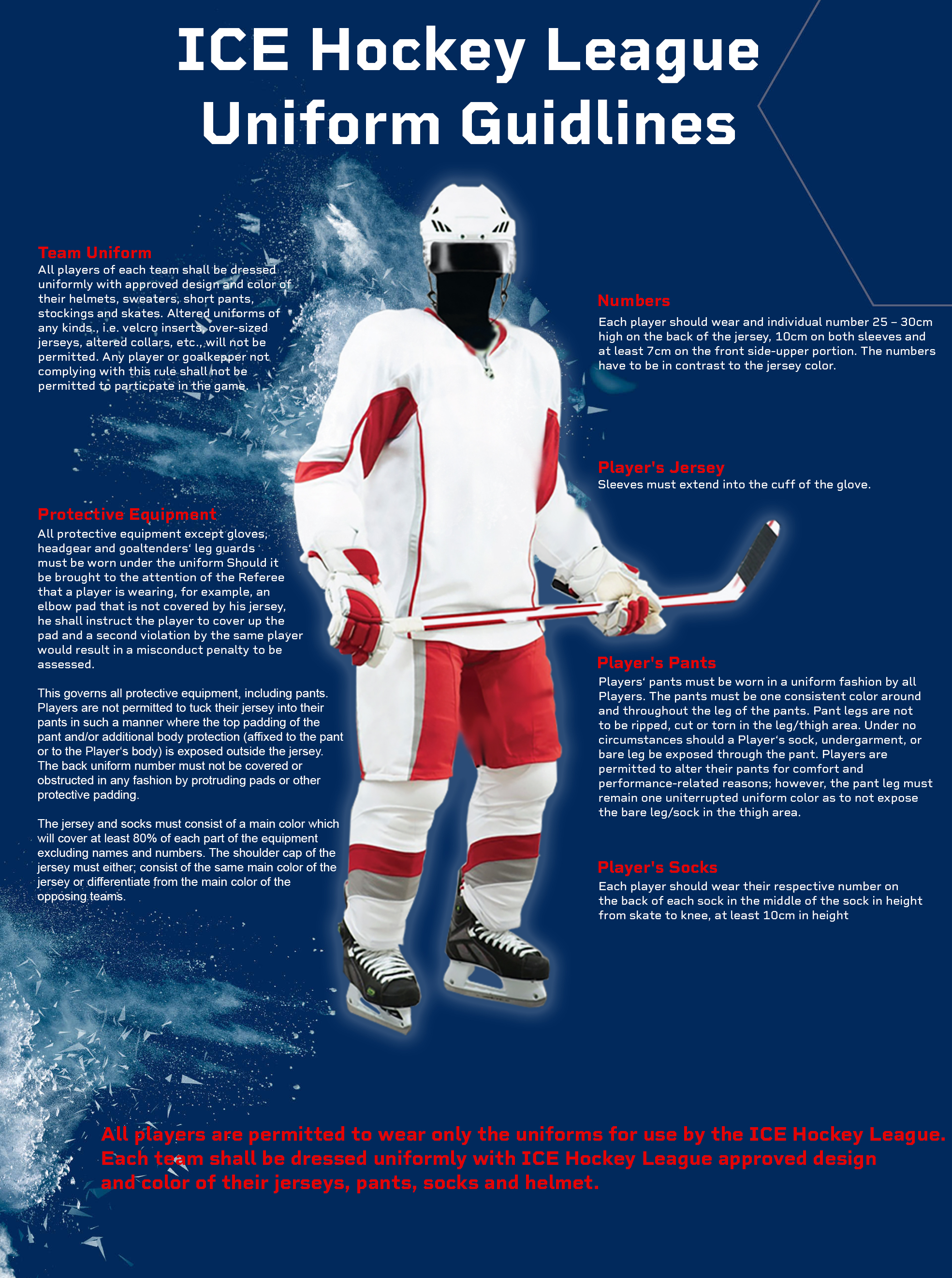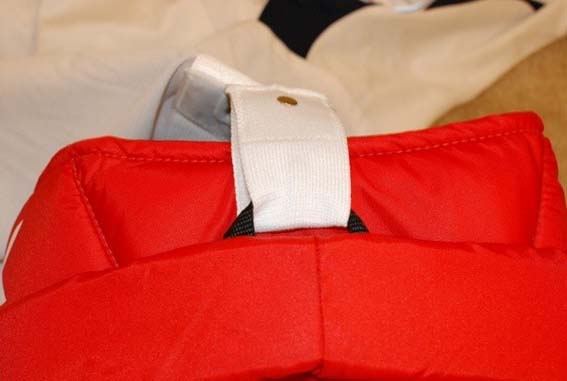
- ICE Hockey League Player Uniforms
Each member club shall design and wear distinctive and contrasting uniforms for their home and road games, no parts of which shall be interchangeable. In cases where the same color is used in both jerseys, the main color used in one jersey must not exceed 10% of the color used in the other jersey. If a team plays with the wrong jersey color this perpetration will be punished according to the ICE Hockey League penalty catalogue. Any concerns regarding a player’s uniform (including the goalkeeper) shall be reported to the ICE Hockey League Hockey Operations Department.- All players from each team shall be dressed uniformly with approved design and color of their jerseys, pants, socks and helmet (except of the goalkeeper, who is permitted to wear a helmet of a different color).
- The jersey and socks must consist of a main color which will cover at least 80% of each part of the equipment excluding names and numbers. The shoulder cap of the jersey must either; consist of the same main color of the jersey or differentiate from the main color of the opposing teams.
- It is recommended, but not required, to have a 3rd jersey of contrasting color. The 3rd jersey will be required in the event 2 teams have jersey outlays close in color.
- Special occasion jerseys (i.e., Halloween, Movember, etc.) are permitted as long as the outlay is sent and approved by the ICE Hockey League Management at least 30 days in advance.
- Jerseys and socks shall be of the same main color (front and back), consisting of a minimum of 80% of the main color, inclusive of advertising color.
- Jerseys must be worn outside of the pants. Jersey and pants must have a tied-down strapping system.

- Each player should wear and individual number 25 – 30cm high on the back of the jersey, 10cm on both sleeves. Numbers are limited to the numbers 1 – 99. The numbers have to be in contrast to the jersey color (dark number on bright jersey and bright number on dark jersey).
- Each player must either:
- Have their respective number on the helmet in a color contrasting with the helmet color. The number must be at least 3cm in height.
- Have their respective number on the back of each sock in the middle of the sock (in height) from skate to knee, in the same color as the number on the back of the jersey. The number must be at least 10cm in height.
- Each player shall wear his name on the upper portion of the back of his sweater, printed 7 - 10cm height.
- The clubs have to secure that the player number is also visible on the front side upper portion of any player jersey in a height of at least seven centimeters.
- Altered uniforms of any kind, i.e. Velcro inserts, over-sized jerseys, altered collars, etc., will not be permitted and subject to disciplinary actions.
- Warm-up jerseys must have player numbers on the back with a height of at least 25cm, and each player must wear the same number assigned to him on the official game sheet. The same applies to the sleeves
- All players from each team shall be dressed uniformly with approved design and color of their jerseys, pants, socks and helmet (except of the goalkeeper, who is permitted to wear a helmet of a different color).
- Player numbers are not transferrable. A number may only be worn in play by one player during a given season. If a player leaves the club, during the season, his number may not be re-used for another player of that club during that season. In the event a short-term issue occurs (i.e. new player, injured player etc.) an exception may be applied to the ICE Hockey League for consent, for a maximum length of 3 games.
- Clubs must communicate to the ICE Hockey League Office in written form, any time before July 15th of each respective season:
- The layout of all jersey versions to the ICE Hockey League Office before production can begin.
- Club jersey, helmet, pants and sock outlay for League approval.
- Choice of dark or light jersey for home games (Subject to the approval of the ICE Hockey League Marketing Department).
In the event, club(s) do not communicate in written form the uniform layout for the upcoming season by July 15th of each year, a fine of €2,500 will be assessed as per the ICE Hockey League Penalty Catalog – Ref. Nr. 64.
The ICE Hockey League Office controls the correct design of the numbers as stated in the regulations, the correct placements of the sponsor-logos as well as the coloring in “bright” and “dark”. It is necessary that colors are used for jerseys with bright basic color as well as for jerseys with dark basic color which can be clearly allocated to the respective color definition (bright / dark). Only after the final approval of the league secretariat jerseys may be used at games of the ICE Hockey League.
- The layout of all jersey versions to the ICE Hockey League Office before production can begin.
- If the produced jerseys have a different color to the color of the layout and in the case of problems by determination of the colors by the TV host broadcaster, the referees, the stats people and/or the ICE Hockey League Hockey Operations, the jerseys must be changed and produced new.
- Each ICE Hockey League club has to ensure that all jerseys (white, dark) bear the league season logogram with a size of 55mm x 90mm (B x H) in the left corner on the front and backside of each jersey. This league season logo will be provided each year by the ICE Hockey League.
- Clubs are not permitted to change the base colors of their jerseys (bright, dark) during ongoing competitions and cannot be negotiated bilateral between both teams of a game. The overview of the jersey colors (home color / second color) which will be established by the league secretary after the layout-deadline is integrative part of the procedure regulations.
- The Referees must ensure that the jerseys worn by each team can be distinguished in television broadcasts. In cases of doubt, the home club has to change jerseys.
- All violations of this rule are subject to being penalized in accordance with the ICE Hockey League Penalty Catalog.